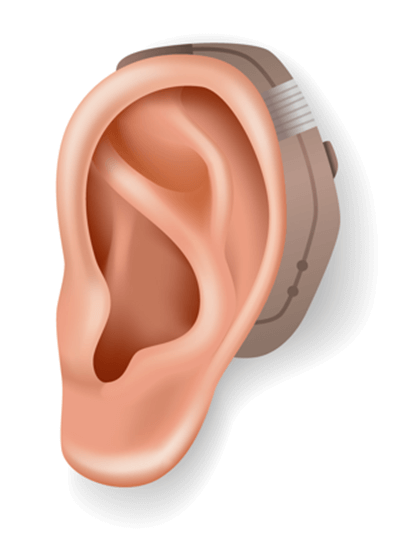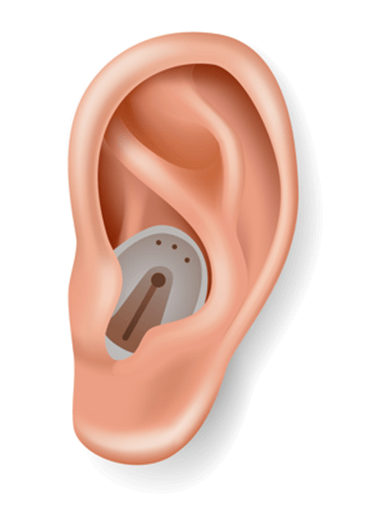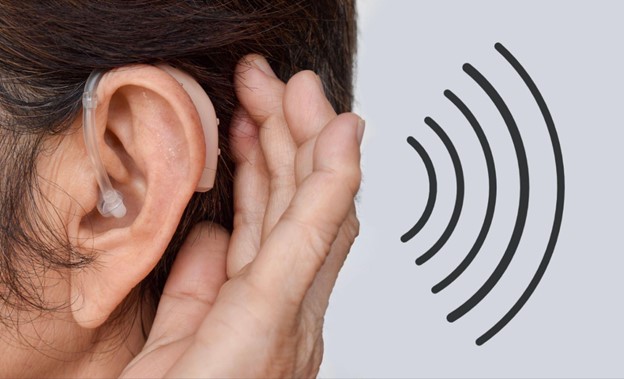Gone are the days of bulky hearing aids. Thanks to modern technological advancements, today’s hearing devices are sleek and, in many cases, almost invisible.
But with so many options on the table, how do you choose the right one? Understanding that your unique needs and lifestyle are central to this decision is essential.
Your personal experience with hearing loss will guide you to the most suitable hearing aid style, as there’s no one-size-fits-all solution.
In this ultimate guide, we’ll explore the various types of hearing aids, providing you with insights to help you understand your choices. We aim to offer an approachable and comprehensive resource, helping you make informed decisions about your auditory health.
Behind-the-Ear (BTE): Versatile and Powerful

When you picture a hearing aid, the classic design that might come to mind is the Behind-the-Ear or BTE style. This iconic design has evolved immensely over the years, adapting to modern needs while staying true to its foundational concept.
One of the most striking changes is in the design itself. If you recall the slightly bulky devices of yesteryears, you’re in for a surprise. Modern BTEs have slimmed down considerably, boasting a sleeker, more discreet profile. Yet, their slender design doesn’t mean a compromise on power.
Central to its design is the placement. The microphone of the hearing aid is comfortably positioned behind the ear. A transparent tube extends from there, connecting the microphone to a receiver nestled in the ear canal. Depending on your hearing loss and ear anatomy, the BTE might be paired with a customised earpiece or a smaller tip known as a dome.
Cleaning and caring for BTEs is a straightforward affair. Their design allows for simple upkeep routines, ensuring your device stays in prime condition for longer.
Receiver-in-the-Canal (RIC): Compact with Natural Sound Quality

While traditional BTEs typically house the receiver within the main case, RICs adopt a different approach. In this model, the receiver extends out from the main case, which is positioned snugly behind the ear. This distinct configuration makes RICs more compact and contributes to delivering a more natural sound quality. Placing the receiver closer to the ear canal can reproduce sound with minimal distortion, enhancing your listening experience.
Now, if you’re someone who values aesthetics as much as functionality, the RIC has you covered. These devices are available in an array of case colours, giving you the flexibility to select one that seamlessly matches your skin tone or hair colour. As with many hearing aid models, modern RICs are designed to blend in.
Adding to the list of conveniences is the modern touch of rechargeability. If you’ve ever been bothered by the recurring need to replace tiny batteries, you’ll appreciate this feature. Many RIC models now come with the option to recharge, ensuring you have uninterrupted sound quality without the hassle of frequent battery changes.
In-the-Canal (ITCs): Convenient Controls at Hand

If you’ve ever thought about integrating hearing aid technology seamlessly into your daily life, the In-the-Canal (ITCs) might be a perfect fit for you.
Whether you’re in a bustling cafe or enjoying a quiet evening at home, adjusting settings such as volume or switching memories becomes incredibly straightforward. This accessibility can be especially beneficial for those struggling with more intricate devices.
However, while they are undeniably convenient, ITCs present a unique challenge. Due to their placement within the ear, they can be more susceptible to wind noise. This is particularly relevant for outdoor enthusiasts or those living in windier climates.
Additionally, for those with vision or dexterity challenges, ITCs can be a blessing. They’re the largest among custom hearing aid variants, making them easier to handle. Whether inserting, cleaning, or even changing their batteries, the ITC design inherently offers more user-friendly experiences.
Completely-in-the-Canal (CIC): The Ultimate in Discretion

CICs boast a deep placement in the ear canal, rendering them virtually invisible to the casual observer. This makes them ideal for individuals who value discretion above all else. If you’ve ever felt self-conscious about wearing a hearing aid, the CIC could be the confidence boost you seek.
Performance-wise, CICs are crafted to assist with a range of hearing losses, specifically mild to moderate-severe ones. This broad spectrum of applicability ensures that many hearing aid users can benefit from its features. Additionally, their positioning deep in the ear offers a natural advantage against common nuisances like wind noise.
However, it’s important to note that the very feature that makes CICs so appealing – their deep placement – can also present challenges. Not everyone’s ear canal will be suitable for CICs. Individuals with particularly narrow or bendy ear canals might find that CICs aren’t the optimal fit for them.
It’s noteworthy to mention that all in-the-ear and in-the-canal hearing aids, including CICs, are custom-made. This ensures they snugly fit the unique contours of your ear canal. A clinician will craft a silicone impression of your ear, ensuring the hearing aid you receive is tailored perfectly for you.
In-the-Ear (ITE): Enhanced Controls for Tailored Usage

ITEs may resemble their close relative, the ITC devices. However, a closer look reveals some stark differences. ITEs are, in essence, a size up from ITCs. Their more substantial size, while still offering discretion, enables them to house additional features and controls that might be absent or challenging to incorporate in their smaller counterparts.
One of the standout features of ITEs is the enhanced control they offer. With the added real estate, ITEs often have memory and volume controls. These controls can be especially handy, allowing users to tailor their hearing experience to different environments.
So, who stands to benefit most from the ITE design? Individuals who might struggle with the dexterity demands of smaller hearing aids would likely find ITEs a more user-friendly option. The controls are more accessible, and tasks like battery replacement become noticeably easier. Furthermore, those who prefer a slightly larger device for comfort or fit might naturally gravitate towards ITEs.
Micro Receiver-In-Canal (micro RIC): The Most Popular Choice

What sets the micro RIC apart from its sibling, the regular RIC? The answer lies in its compactness. The micro RIC boasts an even smaller and more streamlined design, ensuring a less intrusive and more discreet fit. Despite its diminutive stature, it doesn’t compromise on performance, offering clear sound amplification and efficient noise cancellation.
The reasons behind its soaring popularity are manifold. One key attribute is the balance it strikes between discretion, comfort, and functionality. Users often find that the micro RIC feels almost natural, sitting comfortably behind the ear without drawing attention. It’s the kind of device that effortlessly blends into your daily life, allowing you to engage in conversations and enjoy sounds without any hindrance.
If you’re seeking a hearing aid that promises discretion without skimping on functionality, the micro RIC is undoubtedly a worthy consideration. With its compact design and the backing of countless positive user experiences, it’s no wonder it’s clinched the title of the most popular choice among hearing aid styles.
Bluetooth Hearing Aids: A Revolution in Connectivity

Traditional hearing aids, while exceptional at amplifying sound, come with limitations when it comes to personal audio devices. Imagine wanting to listen to a podcast or music on your phone. With a conventional hearing aid, you’d usually have to remove it to pop in earphones, a tedious task fraught with the risk of losing or damaging your aids.
Bluetooth hearing aids, on the other hand, bridge this gap beautifully. They’re designed to connect directly with Bluetooth-enabled devices like your smartphone, tablet, or even your television. This means you can have your favourite song, that gripping audiobook, or the dialogue from a film streamed straight into your hearing aids. The best bit? No fumbling around, removing, or replacing aids. So, if you’re watching a film and you’re finding the audio a bit soft, you can have it streamed directly into your hearing aids for a clearer, sharper listening experience.
Rechargeable Hearing Aids: Powering Up Convenience

The constant need to change batteries in traditional hearing aids can be both inconvenient and challenging. Swapping out tiny batteries can become a regular nuisance, especially for those who might find handling minute objects difficult. Beyond that, there’s also the environmental concern of disposing of used batteries.
Rechargeable hearing aids are a breath of fresh air for these very reasons. Instead of the routine battery change, users can simply plug in their hearing aids, like a mobile phone, letting them power up overnight.
Come morning, you’re greeted with a device ready to serve you through the day without a hiccup—no fumbling, no fussing, just straightforward charging.
Primarily, behind-the-ear styles have adopted this technology, given the space they offer for housing the rechargeable components. However, as technology advances, the industry is witnessing a shift.
Now, even some sophisticated in-the-ear models are hopping on the rechargeable bandwagon, ensuring users have a broader range of choices without compromising convenience.
Customising Your Hearing Aid: Ensuring Sound Precision and Comfort
Every journey towards a perfect hearing aid fit begins with an initial hearing test. This is where audiologists determine the specific nuances of your hearing loss. Once the extent and type of hearing loss are charted out, the process moves on to the next vital step – creating a mould of the ear canal.
This mould is not just a replica of the ear’s shape but a guide. A guide that ensures the hearing aid sits snugly and comfortably, offering the user the best possible sound experience. This moulding process is particularly crucial for in-the-ear and in-the-canal hearing aids, given their intimate positioning within the ear’s structure.
A well-fitted hearing aid is more than just comfortable; it’s optimal. A snug fit ensures that sound is channelled correctly, minimising feedback or whistling noises that can arise from improperly fitted devices. It also reduces the risk of the hearing aid falling out or shifting during daily activities.
Comfort, of course, is paramount. An ill-fitting device can cause soreness or discomfort, discouraging consistent use. On the other hand, a hearing aid tailored for the user encourages daily wear, ensuring the user fully benefits from the device.
All in-the-ear and in-the-canal hearing aids should ideally be customised. While the outer design of these aids may seem similar, the precision required inside is what makes the real difference.
A tailor-made fit guarantees sound clarity and ensures that the wearer’s experience is as smooth and comfortable as possible. After all, the goal is clear hearing with a touch of personal comfort.
Do You Need Help in Choosing Your Hearing Aid?
Modern hearing aids have undergone significant technological advancements, resulting in sleeker designs, enhanced functionality, and improved comfort. Choosing the right one can be daunting, with many styles and features available.
This is where Freedom Hearing can help. We can help you understand your needs and assess your lifestyle so we can guide you in choosing the best hearing aid style. We can also connect you to funding options that make it easier to overcome your hearing loss.
Please book an appointment to see one of our audiologists or call 1300 689 085.

